Introduction
All over the country, states and local governments are adapting to a constantly and rapidly changing federal landscape. The Infrastructure Investment and Jobs Act (IIJA) will sunset in 2026 and, in the interim, the Trump Administration has made adjustments to the criteria of a number of the IIJA’s discretionary and formula programs. In some cases, IIJA programs that communities were considering or developing application materials for may no longer serve the needs of, or be eligible to fund, those projects. In such a shifting federal landscape, localities should prioritize working internally and with regional partners to develop coordinated project plans that can span administrations and insulate individual projects from sudden federal priority changes.
Even so, changing the built environment of a community requires extensive planning and development work long before shovels ever hit the dirt. The demands of planning, financing, and delivering complex infrastructure projects necessitate alignment with a broader community vision and stewardship through multiple, dynamic political and economic cycles. Comprehensive plans, strategic plans, and neighborhood master plans – collectively referred to as “long range plans” in this resource – can be empowering tools to define that shared vision and support the local stewardship.
Unlike project level plans that have a narrow focus and shorter time horizon, long range plans typically take on a greater time horizon (i.e., 10 or more years) and have a broader scope, encompassing a neighborhood, municipality, or region. The result is a document with a clear community vision and goals that serve as guidance for long-term investment decisions and local policymaking, like that around land use. These long range plans set the stage for pursuit of future formula funding and competitive grants.
This resource will focus on two community long range plans: Imagine Dubuque, encompassing the City of Dubuque, Iowa; and the Kirkpatrick Heights/Greenwood Master Plan focused on redevelopment within the historically black community in the Kirkpatrick Heights and Greenwood neighborhoods in Tulsa, Oklahoma. This resource will also reference a long range plan discussed in prior resources, Kalamazoo, Michigan’s Imagine Kalamazoo 2025 plan, which has supported their pursuit of federal funding.
|
Imagine Dubuque (Dubuque, IA) |
Kirkpatrick Heights-Greenwood Master Plan (Tulsa, OK) |
Imagine Kalamazoo 2025 (Kalamazoo, MI) | |
| Population | 59,667 (2020) |
413,066 (2020) 5,356 in study area (2021) |
73,598 (2020) |
| Scope | Imagine Dubuque serves as the comprehensive plan for the City of Dubuque | Redevelopment of three publicly owned sites within the Kirkpatrick Heights and Greenwood neighborhoods in Tulsa | Imagine Kalamazoo 2025 includes the Strategic Vision, which outlines 10 strategic goals to guide the City’s work, and the Master Plan, serving as the road map for City projects. |
| Timeline | Developed in 2017, with a time horizon going to 2037 | Developed in 2021-2022. The Master Plan envisions a multi-decade buildout of the publicly owned sites. | The 2025 Master Plan was approved in October 2017. The Master Plan is reviewed every 5 years and updated at least every 10 years. |
Imagine Dubuque 2037: A Call to Action Overview
Imagine Dubuque is the City’s 2017 comprehensive plan, which built upon the prior plan adopted in 1995. The plan was developed over a 13-month period and heavily emphasized community engagement. Imagine Dubuque includes 110 recommendations, split across seven categories (Economic Prosperity, Sustainable Environment, Social + Cultural Vibrancy, Livable Neighborhoods + Housing, Community Facilities, Transportation + Mobility, and Land Use). Since completing the plan, per the implementation dashboard, the City has completed seven of the recommendations, with 83 in progress and on track (as of May 2025). The plan has been leveraged by the city to support grant applications, including a successful RAISE grant application.

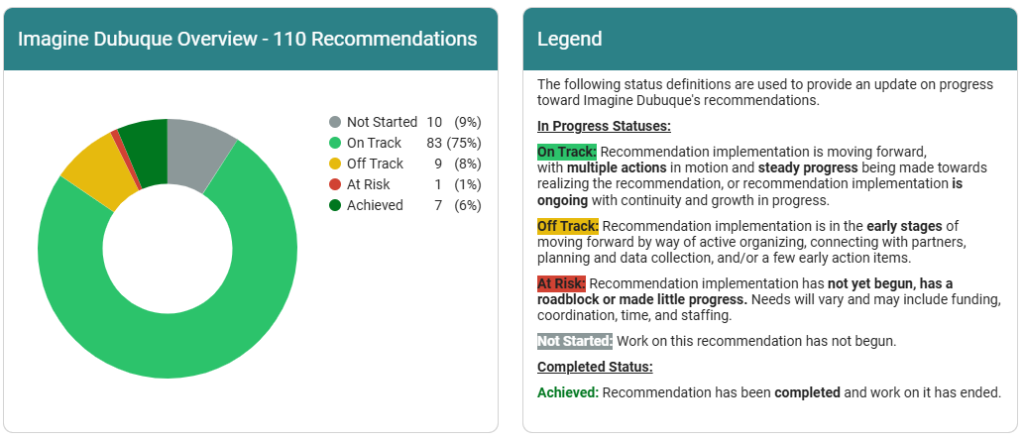
Kirkpatrick Heights/Greenwood Master Plan Overview
The Kirkpatrick Heights/Greenwood Master Plan was developed under the leadership of the City of Tulsa and Partner Tulsa, the city’s economic and community development organization, and is now being implemented under the leadership of the Greenwood Legacy Corporation (GLC), a purpose-built Community Development Corporation. The master plan defines the community’s vision and creates a framework for development of three publicly owned, underutilized sites within the context of the historically black Kirkpatrick Heights/Greenwood neighborhood. Many of these residents are descendants of Tulsa’s Black Wall Street, victims of the horrific 1921 Tulsa Race Massacre, and have been impacted by decades of disinvestment following urban renewal and red lining. The plan’s development coincided with the centennial of the 1921 Massacre and leverages the public acquisition of the underutilized sites in 2018.
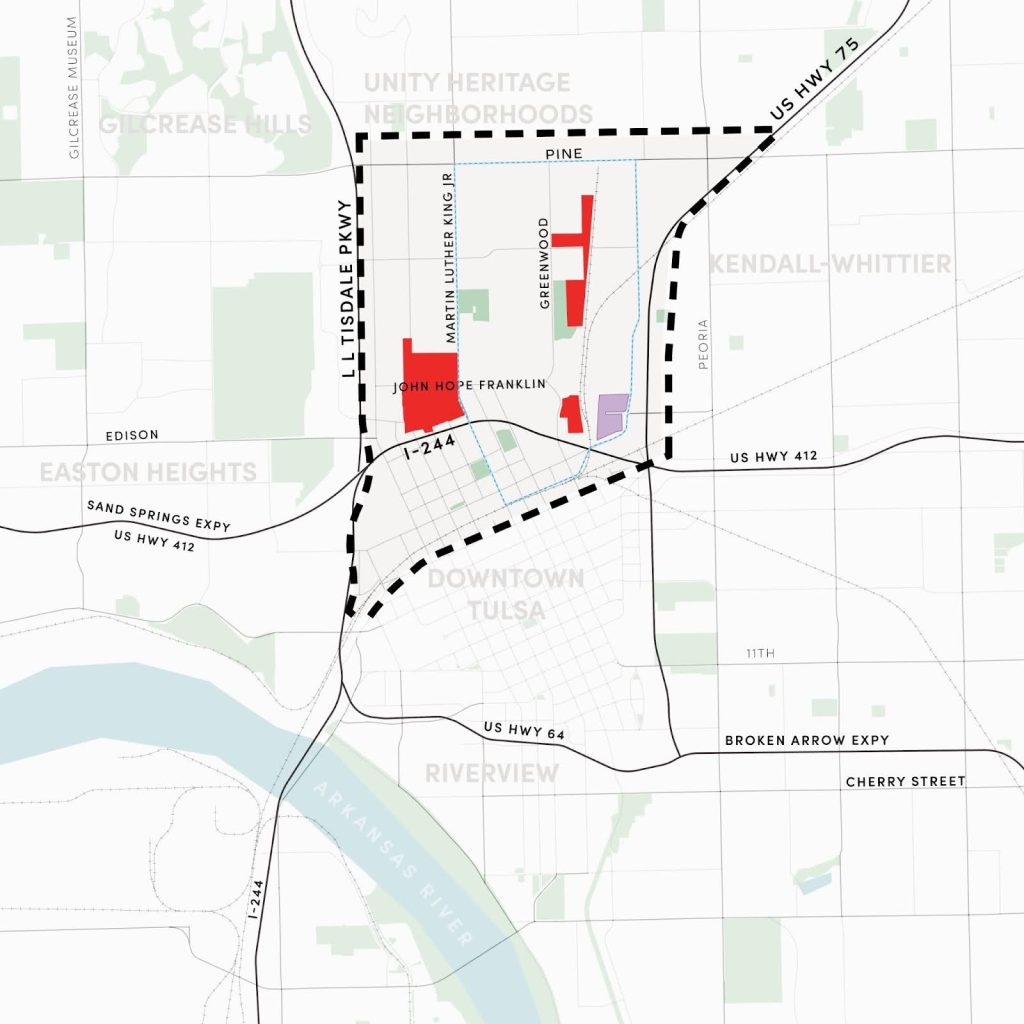
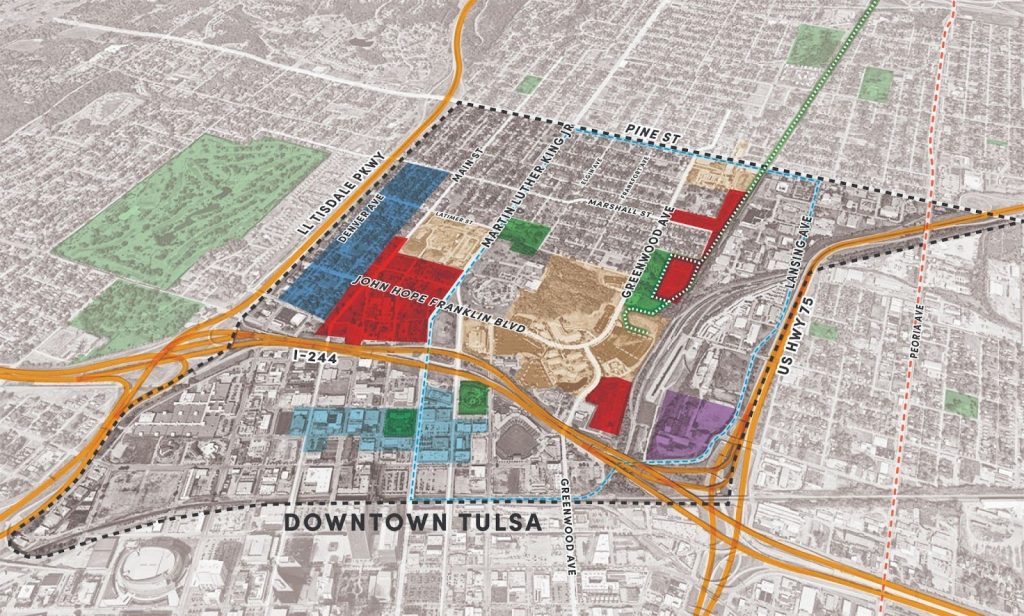

Imagine Kalamazoo 2025 Overview
Imagine Kalamazoo 2025 (IK2025) consists of two components. The Strategic Vision is the guiding document for the City, as informed by the community’s priorities and vision for their future. The document outlines Strategic Goals to guide the City’s work and provide a framework for all other City plans. The Master Plan serves as the road map for City projects. It shapes the City’s future built environment by guiding growth and development, preserving the City’s unique character, and enhancing Kalamazoo’s neighborhoods. The Master Plan focuses primarily on land development and transportation. The IK2025 Master Plan and Vision are the culmination of 16 months of public discussion which engaged over 4,000 community voices.
In Kalamazoo, the Master Plan is reviewed every 5 years and updated at least every 10 years. The IK2025 Master Plan, the focus for this resource, was approved in October 2017. Kalamazoo recently launched the Imagine Kalamazoo 2035 process, the next iteration of their Strategic Vision and Master Plan.
All three set forth a long range vision and specific recommendations for action, with the Kirkpatrick Heights/Greenwood Master Plan focusing on a neighborhood within the City of Tulsa while Imagine Dubuque and Imagine Kalamazoo 2025 lay out plans for their respective cities over a 20 and 8 year time horizon respectively.
Components of Long Range Plans
Local governments regularly participate in many long range planning efforts governed by various federal, state, regional, and local processes. There are strategic multi-modal transportation plans and transportation improvement plans or TIPs, often in concert with the state DOT and/or metropolitan planning organization (MPO). In fact, every state is required to develop a State Transportation Improvement Plans or STIPs covering a period of at least four years and must be developed in coordination with MPOs, transit providers, regional transportation planning organizations and, according to US code, “must be compatible with the TIPs for the state’s metropolitan areas.”
Additionally, there are land use plans, usually known as “comprehensive plans,” with regular updating mandated by state statute. Mayors and County Executives frequently pursue long range vision plans or multi-year strategic plans. All of these planning efforts can form a solid foundation for future project level work and establish a community’s priorities for grant applications and funding opportunities. The specifics of any long range plan will vary by context, community, and scope, but they are all built on meaningful community engagement.
Community engagement
A key part of any long range plan is a co-developed, shared vision for a community’s long-term aspirations, which will then be used to guide policy, land use, capital investment, and development decisions. Robust and intentional community engagement is a critical component of any effective long range plan.
For example, Imagine Dubuque’s community input campaign lasted over 12 months of the 13-month development period. During that year, they engaged over 6,000 community participants who collectively produced 12,500 ideas through one-on-one conversations, surveys and online submissions, and workshops. A full chapter of Dubuque’s comprehensive plan is dedicated to their community engagement. A key plank of their engagement strategy was to maximize resident interaction by meeting people where they were. The Imagine Dubuque Team made an effort to have visibility at community events, pop-ups, farmers’ markets, and more to allow for more passive and casual opportunities to connect with community members.
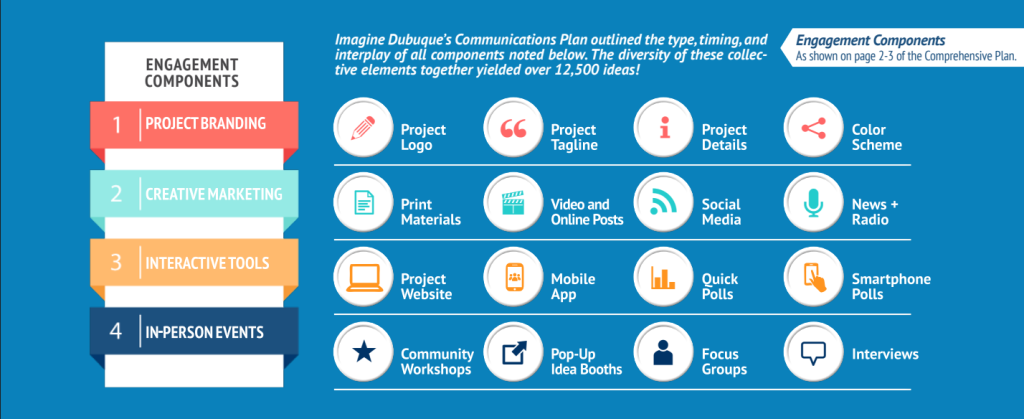
Throughout the Imagine Dubuque engagement process, the planning team leveraged data collected via optional demographic questions to ensure that those participating in community engagement were representative of the population. In reviewing this data halfway through the process, they realized that students and seniors were underrepresented. To address this, the Imagine Dubuque team held presentations at area senior homes to raise awareness and gather feedback. Additionally, a news article about the planning effort was published in The Golden View, a monthly publication distributed in the area whose primary audience is seniors. To engage students and younger populations, they placed idea boxes and comment cards at local schools, universities, businesses, and living facilities. The expanded and targeted engagement effort generated over 500 new ideas in less than three months from all parts of the community, and ensured that engagement demographics aligned with those of the City.
“Community engagement was the single-most pivotal and influential factor of Imagine Dubuque. The Plan’s findings and recommendations, showcased in the chapters that follow, are directly derived from the engagement process, as celebrated by the infographics and outreach statistics therein. Only through the participation of the community was the City capable of developing a relevant and meaningful plan for the future of Dubuque.” – Imagine Dubuque (page 2-9)
Whereas Dubuque needed to cast a wide net across the entire city, PartnerTulsa was very intentional in developing a targeted footprint for community engagement to inform the Kirkpatrick Heights/Greenwood Master Plan. This curated approach was important for several reasons.
First and foremost, PartnerTulsa and the City wanted to prioritize community members within or near the project area who would be directly impacted. Additionally, given the historical sensitivity of the project area and the deep mistrust between the community and local government, the staff team strived to ensure their actions closed the trust gap rather than further exacerbate it. It was imperative that PartnerTulsa and the City act intentionally in building trust with community members early, and prioritize transparency throughout the plan’s development process to maintain that trust.
As laid out in their community engagement report, Kirkpatrick Heights/Greenwood engagement occurred across three rounds. The first round, oriented around two community meetings with 135 attendees, introduced community members to the project and developed a community-led vision for the study area and publicly-owned sites. Following brief presentations, PartnerTulsa hosted an open house, with various stations organized by topical areas pertinent to the project: community amenities and needs, planning and development context (i.e., where people live and how they move around the community), and resident interviews focused on their lived experience in the community. During this first round of engagement, local leaders also hosted pop-ups at schools and community events, neighborhood association meetings, and conducted stakeholder interviews with groups like the Greenwood Chamber of Commerce, Black Wall Street Chamber of Commerce, Oklahoma State University offices, churches, the local housing authority, and community foundations.
The second round of engagement sought to build on the first round of feedback, research, and analysis to further refine the overall framework for development of the long range plan; this round included multiple student workshops at K-12 schools, focus groups, and community design charrettes. The planning group also hosted presentations from representatives of the Houston Land Bank and the Africatown Land Trust in Seattle on different models for facilitating development that ensured local stakeholders had a role in owning and governing the implementation process. In focus groups on the implementation structure, participants emphasized the importance of partnerships, as well as the need for the organizational structure to match the community’s mission and purpose. The community also recognized the value of Community Benefit Agreements, which can be incorporated in any development process regardless of the organizational structure.
The third round of engagement was kickstarted by the draft plan reveal event, which included online and in-person surveys to garner feedback and gather community comments.
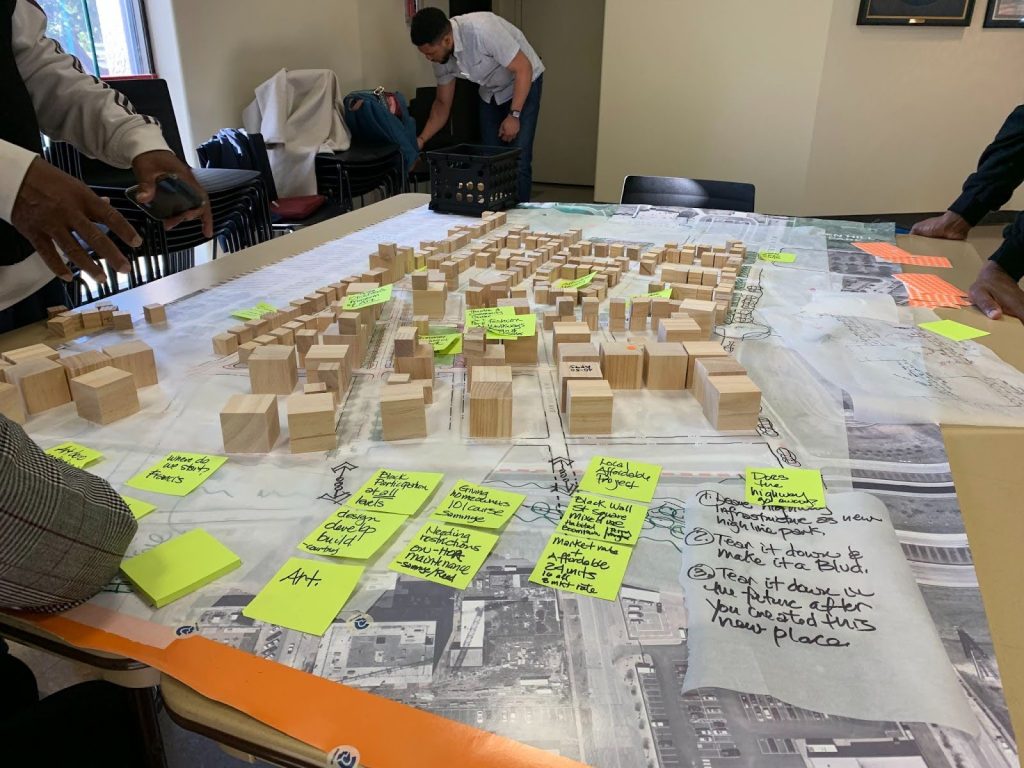
Key themes that emerged from the three rounds of engagement that were instrumental in finalizing the plan include:
- Ensuring equity, ownership, and wealth-building for Black residents;
- Ensuring local and community benefits throughout the project;
- Continuing emphasis on transparency;
- Promoting safety, security and maintenance; and
- Creating a vibrant, active, and welcoming district.
Community engagement does not end with the plan’s publication. For the Kirkpatrick Heights/Greenwood Master Plan, PartnerTulsa and the City have prioritized continued communication as implementation commences to maintain trust with the community. The communication strategy is driven by their efforts to ensure that community members understand the work taking place and how it is enabling the realization of the community vision. This entails regular updates at all milestones, whether that be grant awards, applications for funding, or completed project components.
Gretchen Mudoga, Senior Community Development Manager at PartnerTulsa and a member of the North Tulsa community, noted their intentionality in communicating progress with the community every step of the day, as she said “it’s about getting out there and being seen, and keeping the course; we’re very intentional about our communication and getting information out every step of the way.” Adding on to this, Dr. Lana Turner-Addison, a co-chair of the Master Plan Leadership Committee and founding board member of the Greenwood Legacy Corporation, said that they are “moving with the community and their voice.”
Using data
Community engagement ensures a long range plan has critical community buy-in and a shared vision. Communities must complement this work with data-driven assessments of proposed projects, to develop cost projections, ensure engineering feasibility, develop cost-benefit agreements, and other data assessments that may be needed for project execution.
Shortly after forming, the Kirkpatrick Heights/Greenwood Master Plan’s Leadership Committee issued an existing conditions report to lay out the current conditions in housing, land ownership, public space, demographics, access, and more. The data gathered in this report informed the greater plan:
- Lower than average wages demonstrate a need to ensure development created opportunity,
- Low home ownership and high rental rates in the study area led the team to ensure that long-term strategies protect local residents,
- Assessments of sub-areas within the study area inform development planning, and
- Retail and commercial assessments illustrated the need for improved accessible, full-service grocery stores and investment in local economic opportunities through local-serving retail and services.
In Kalamazoo, MI, as profiled in a prior case story, the City leveraged their Imagine Kalamazoo 2025 plan alongside a retail market analysis to quantitatively demonstrate the economic potential of converting one-way roads into safer two-way roads – prioritizing safety and accessibility over speed. The Downtown Kalamazoo Retail Market Analysis found that the conversions to two-way roads would add an estimated $20 million in retail revenue, as well as 52,000 square feet in leasable space in the area.
Dubuque tapped into data from their long range plan to quantify the air quality benefits associated with promoting active transportation and public transit modes, as well as better coordinated land use decision-making – both of which are called out in the Imagine Dubuque plan as contributing to local air pollution.
Having this data from the outset enables local leaders and community members to understand the baseline starting point, local economic trends, investment and service gaps, and community impacts – all of which are critical to the planning and implementation processes.
Implementing and Executing Long Range Plans
Releasing the final long range plan is not the end of the road, but rather just the beginning of the work necessary to realize the shared vision. Local leaders and community members should consider the implementation phase throughout the planning process and co-develop an implementation plan/roadmap that sequences policy changes, projects and initiatives, identifies responsible departments or community organizations, and outlines steps for execution.
Organizing for implementation
In some cases, a first step may be standing up a new organization to steward the plan to fruition, as was the case for Tulsa and the Kirkpatrick Heights/Greenwood Master Plan. During the community engagement process, neighborhood residents expressed concerns about “who” would be the stewards of the long range plan and drive its implementation forward. Several implementation and organizational structures were considered and eventually a Community Development Corporation, or CDC, was established to lead the plan called the Greenwood Legacy Corporation (GLC). In addition to recommending the formation of GLC, the plan evaluates other measures to guide the development and implementation, including Community Land Trusts, and Community Benefit Agreements. By including clear guidance for implementation and the organizational structure, the community’s vision is better insulated from sudden shifts in political and economic dynamics that could influence the future of three publicly owned sites.
In Imagine Dubuque’s final chapter, “A Call to Action,” Dubuque outlines responsibilities for discrete projects and initiatives with assignments for relevant city offices and departments. The chapter identifies the roles of different partners across sectors within the city including those in sustainability, support services, education, community care, business, and governance. Each recommendation/initiative is then matched to the requisite partners in the chapter, fostering the development of strong connections across the community to enable effective implementation. Since then, the City has converted the plan’s original website from one geared towards gathering feedback to one that highlights implementation progress. Today, community members and partners can find a regularly updated implementation dashboard that is broken down in accordance with the plan’s seven categories and each of the 110 recommendations. The dashboard is an intentional effort to increase transparency in Imagine Dubuque and foster a dialogue between City Hall and residents on the plan’s successes, as well as its setbacks or needed changes.
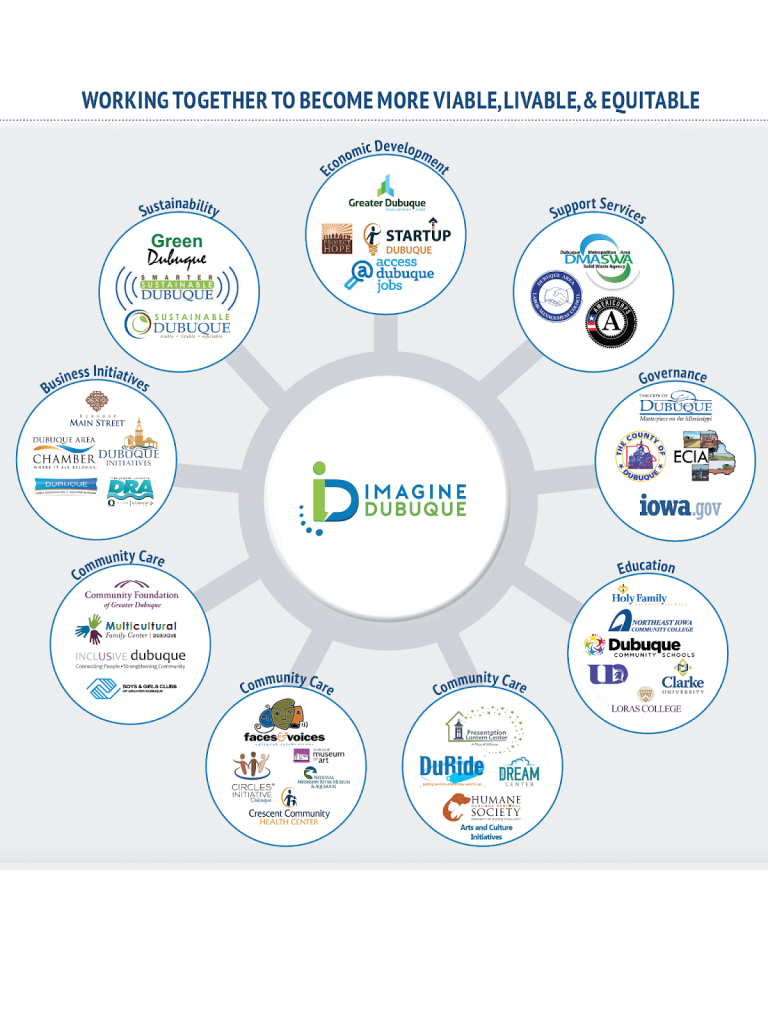
Managing long range plan implementation through change
The time horizon for long range plans typically go well beyond those of economic or political cycles; while they may originate due to a certain political or economic context, successful implementation requires they persist beyond a singular economic moment or political actor. This reality necessitates local leaders take steps to ensure that the long range plan is resilient and adaptable to changing circumstances and it can be applicable across political administrations to be in service to the whole community and long-term aspirations.
Imagine Dubuque was developed in 2017 under Mayor Roy D. Buol and prior to the pandemic. Like the vast majority of cities, COVID-19 had a dramatic effect on Dubuque’s downtown, given the shift to remote and hybrid working. Challenges with housing affordability have also accelerated across Dubuque since the pandemic.
Under the leadership of current Mayor Brad Cavanagh, the City has adapted implementation of their long range plan to account for the impacts of the pandemic on work and residential trends, namely the rise of remote work. As a result, the City has underutilized public spaces in their commercial areas, and they are working to invest in projects to promote housing development. In September 2022, Dubuque’s City Council approved an expansion of financial incentives for affordable housing development that is aligned with and was, in part, motivated by the long range plan.
As Dubuque City Planners Jason Duba and Wally Wernimont noted, there are two key factors that have enabled the plan to maintain relevance through change and continue to guide the city in the long run. First, Dubuque sought to develop the plan in a way that laid out specific projects and actions in the near-term, while focusing more on principles (e.g., the need for more mobility options) to underpin their long-term vision. For example, Duba and Wernimont highlighted the plan’s near-term intent to incorporate a suburban water system into the city’s own as well as broader, longer-term recommendations like designing Complete Streets. From a strategic perspective, Duba and Wernimont suggest that planners should aim to balance their long range plans with general goals as well as targeted, specific projects. Second, extensive community engagement at the onset can insulate a plan through governance transition. As Wernimont noted, “the voice of the plan comes from the community as a whole.” In other words, it is incumbent on local elected officials to act on the plan the community has already been key in developing.
Financing project execution
By attracting private or public investment, or both, long range planning documents can be a powerful tool for illustrating the community commitment and buy-in for a shared vision. The plans demonstrate to funders that the community is prepared to engage in long-term financial commitments for complex capital investments in transportation infrastructure, housing, mixed use and public amenities.
In Tulsa, local leaders noted the value of their data-based needs assessment and engagements informing grant pursuits at the local, state, and federal levels. Their usage of quantitative assessments has also helped them to navigate a dynamic political context while pursuing projects given that data enables them to pursue a narrative grounded in objective data which demonstrates the effects of past decisions and disinvestment on the local community, and how that informs today’s investment decisions.
The community engagement processes and data-driven assessments that are conducted for long range plans can also be leveraged to support grant applications. PartnerTulsa found tremendous value in the data embedded in the Kirkpatrick Heights/Greenwood Plan’s needs assessment and its ability to inform grant applications at the local, state, and federal levels. That objective data has enabled PartnerTulsa and now the Greenwood Legacy Corporation to develop grant narratives for programs such as Build America Bureau’s Innovative Finance and Asset Concession Program and EPA’s Community Change Grant program that demonstrate the effects of decision making from Tulsa’s past, the subsequent disinvestment within the Greenwood community, and how that informs today’s investment strategy and goals.
For example, a comprehensive community engagement narrative can effectively communicate robust constituent support for a plan’s project components and contribute to those components’ inclusion in a state transportation improvement plan (STIP). Further, when vying for state or federal discretionary grant dollars, inclusion in a STIP can be a key metric of a project’s support and, therefore, investment security. Being able to demonstrate a high level of community and financial support can also be instrumental in attracting private investments, especially when a plan can be used to show the long-term vision for a community and specific projects.
Imagine Dubuque’s clear community goals around Complete Streets helped the City to pursue and win a grant for a railroad overpass, supporting investments in making their streets more pedestrian-friendly. In discussion with Dubuque’s planning team, they talked about how to align principles in the long range plan and existing design plans with specific grants. For example, in 2017 when the plan was developed, the City did not know about RAISE grants, then known as BUILD under the first Trump Administration. As Wally Wernimont noted, Imagine Dubuque’s development has prepared the City to be ready as new funding opportunities emerge and arm them with data, community feedback and pre-development necessary to be competitive. Further, through collaboration across city offices – like the planning, economic development, and engineering departments – the City can see how funding opportunities match up to implementation goals and needs before getting backing from City Council to pursue grant opportunities. One instance of success here was in their 2022 RAISE planning grant and eventual 2024 RAISE capital grant for the construction of a railroad overpass on 14th St. The project, Building Bridges to Elevate Employment, will spur further development on Chaplain Schmitt Island, Kerper Boulevard, 16th Street, and the Central Avenue and White Street corridors.
In Kalamazoo, the community identified ten strategic goals as part of the Imagine Kalamazoo 2025 plan; goals around mobility, improving public spaces, complete neighborhoods, and economic prosperity have informed their successful pursuit of grants for various surface transportation and resilience projects. Being able to point back to the existing, explicitly defined community vision and goals strengthened their grant applications.
Conclusion
Amidst periods of political and economic transitions, a long range plan can serve as a north star for capital investment planning and financing. By leaning on the community’s shared vision for the future of their neighborhoods, city, or region, local leaders can have a north star for how they assess prospective investments and how they pursue public and private financing for capital projects.
By grounding day-to-day infrastructure decision making in community-developed, long range plans, local leaders can ensure that they are responsive to local asks and further efforts to transform their regions. When developed and used appropriately, planning efforts can open and expand channels of communication with specific neighborhoods, underrepresented population groups, and stakeholders to bolster trust in the government and its aims. Like the Greenwood Legacy Corporation, long range plans can identify and empower emerging community leaders with a renewed sense of ownership in their neighborhood’s future while, at the same time, distributing power around a project or projects to ensure long term viability. In periods of political transition, be it local, statewide, or national, long range plans allow a community a compass by which they can chart a path forward, constantly referring back to the plan’s goals to gauge next steps, next opportunities, and stay faithful to the residents who count on them.
Accelerator for America would like to thank Drexel University Nowak Metro Finance Lab for their partnership in production of this case story for the Local Infrastructure Hub.



